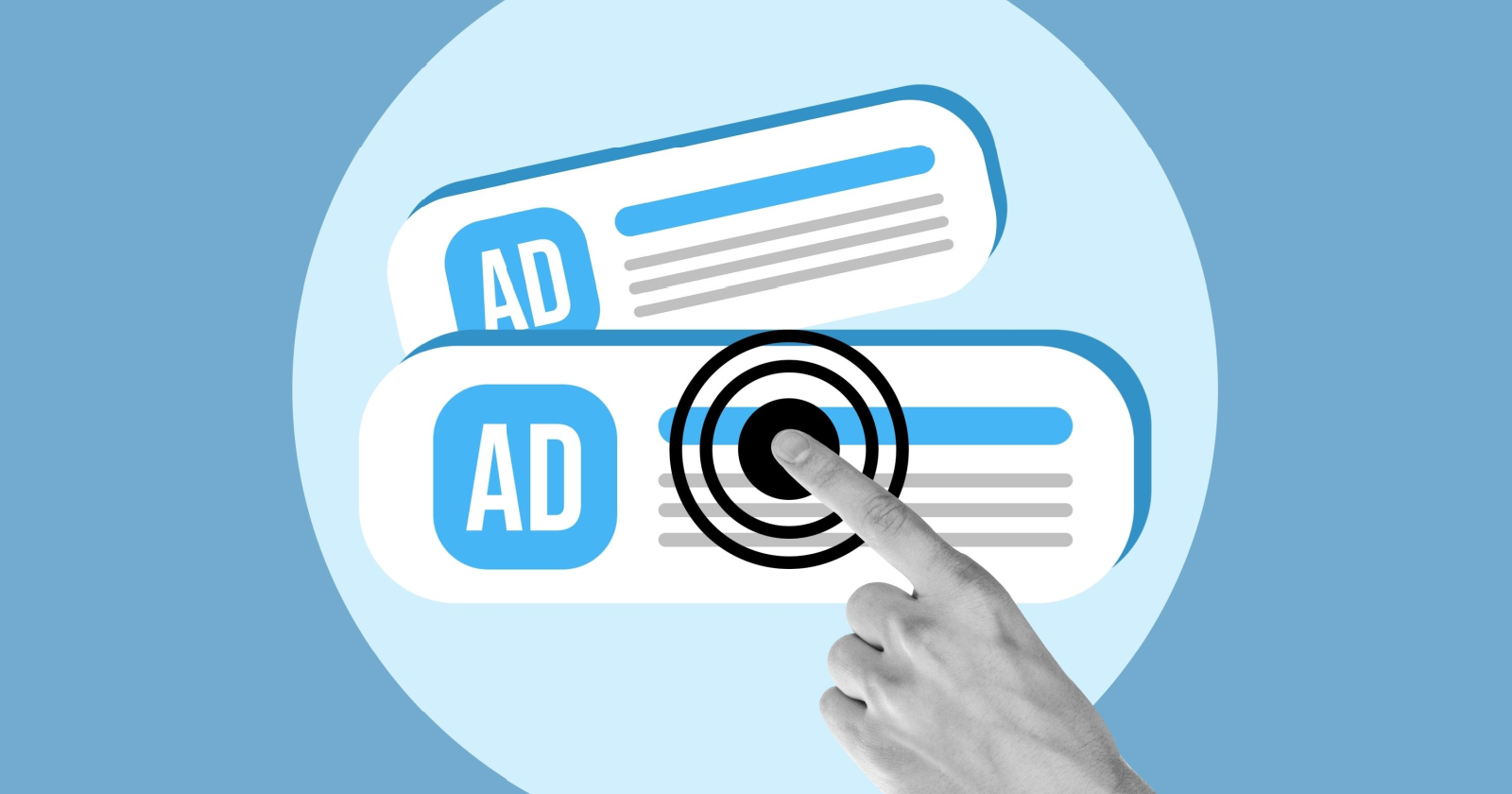When Performance Max launched in 2021, many advertisers weren’t sure what to expect.
It promised access to all of Google’s inventory in a single paid search campaign, but gave us very few levers to actually influence performance. For brands used to having more control, that was frustrating.
Since then, a lot has changed. Google has spent the past year rolling out meaningful updates, many based on advertiser feedback.
From campaign-level exclusions to channel reporting and more asset-level insights, Performance Max (PMax) is becoming more transparent and easier to work with.
That doesn’t mean it’s a set-it-and-forget-it campaign type. But, it does mean advertisers now have more tools to guide performance, troubleshoot issues, and use PMax in a more strategic way than we could before.
How Does Performance Max Work?
Performance Max is a campaign type that allows advertisers to access all of Google’s ad inventory from one campaign. This inventory includes placements in:
- Search (and Search Partners).
- Display.
- YouTube.
- Shopping.
- Discover.
- Maps (via local assets when applicable).
- Gmail.
It utilizes Google’s machine learning capabilities and AI to help drive more conversions, as a complement to existing Search campaigns.
Instead of building separate campaigns for each channel, you upload your creative assets and set a conversion goal. Then, Google’s AI dynamically assembles and delivers ads to the users it believes are most likely to convert.
It combines signals like intent, behavior, demographics, and your audience lists to determine where and when to show your ads. You don’t control keyword targeting directly. Google does that for you using automation.
It’s a shift in mindset: Instead of managing placements and match types, your job is to feed the system high-quality creative, structured data, and clear goals.
Budget & Bidding
Performance Max supports the same Smart Bidding strategies available in other Google Ads campaigns:
- Maximize conversions.
- Maximize conversion value.
Additionally, you can set an optional target return on ad spend if using “Maximize Conversion Value” or an optional target cost-per-acquisition if using “Maximize Conversions” bid strategy.
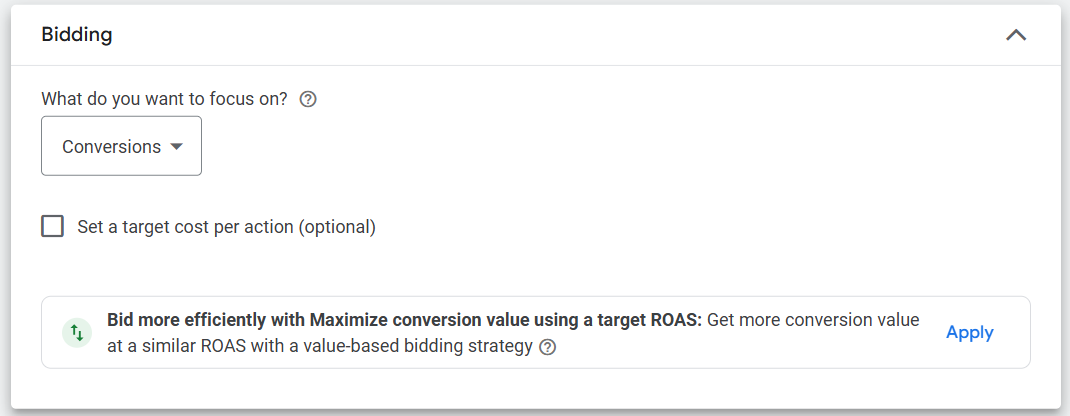
Next, you have the option to bid differently for new customer acquisition.
By default, the option is set to bid higher for new customers. This means the campaign will still reach all potential customers, but prioritize net new customers with a higher bid.
In order to use new customer acquisition, the following inputs are required:
- The bidding strategy type needs to be “Maximize Conversion Value.”
- An audience segment with at least 1,000 active members to help identify existing customers.
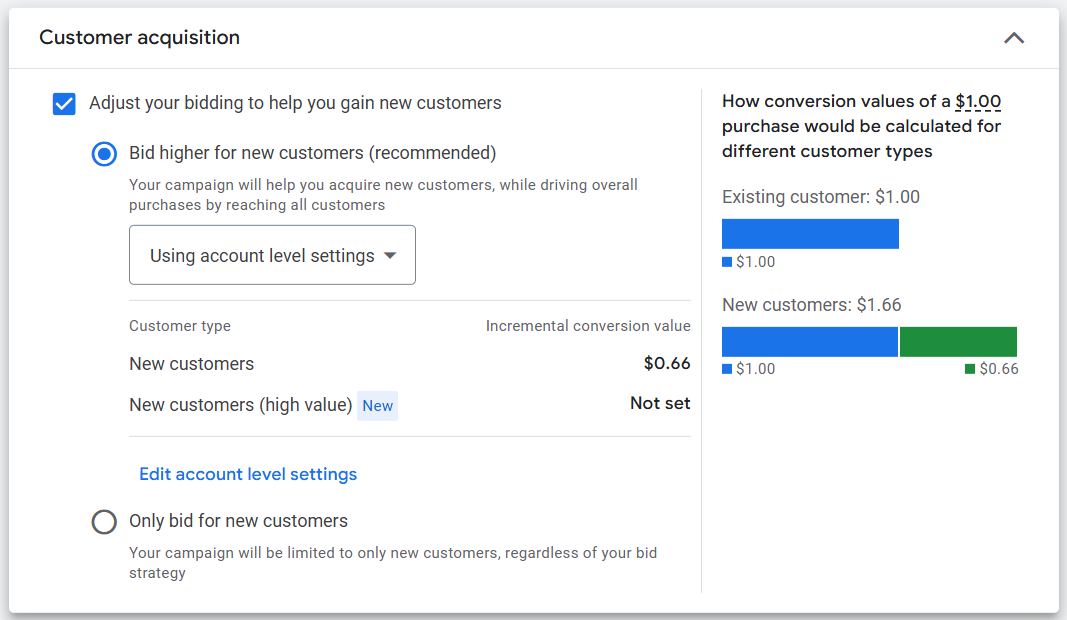
Google has recently introduced Smart Bidding Exploration, which expands your targeting beyond historically high-performing queries to help you discover new opportunities. It’s not exclusive to PMax, but it aligns with its automation-first approach.
Budget-wise, PMax campaigns are flexible, but because they serve across all channels, you may find that spend gets pulled into cheaper (but not always more effective) placements unless closely monitored.
Location, Language, And Ad Scheduling
Up next with a new PMax campaign setup is your location, language, and ad scheduling.
If you need to add a large volume of individual locations, Google Ads Editor fully supports this function. You can also bulk upload them in the online interface by clicking on “advanced search”:
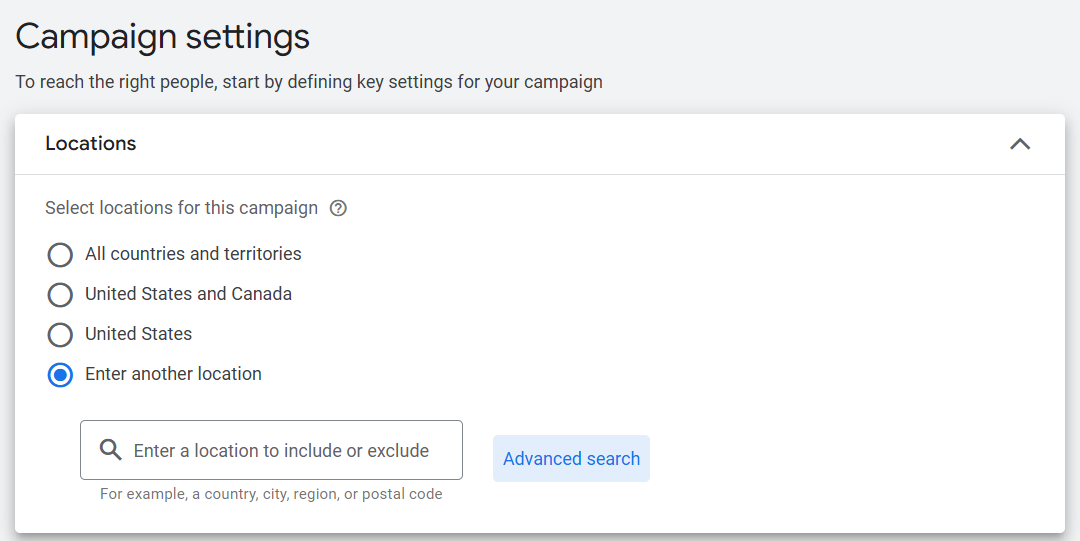
After that, you’ll choose targeted languages, ad schedule (if applicable), and campaign run dates.
What Type of Campaign-Level Controls Does Performance Max Have?
Early versions of Performance Max left advertisers with almost no ability to steer campaigns. But, that’s changed over time.
As of 2025, you now have more tools to shape your campaign at a high level, including:
- Campaign-level negative keywords: Block irrelevant queries without relying on account-wide lists.
- Brand exclusions: Prevent your ads from showing for branded searches you don’t want (useful for retailers or resellers).
- Age exclusions: Exclude certain age groups from seeing your ads.
- Device targeting: Exclude mobile, desktop, or tablet if your conversion performance varies by device (this is a binary on/off exclusion, not a bid adjustment lever).
- URL contains rules: Control which product pages feed into your campaign using a landing page structure.
While still not as precise as traditional Search, these controls let you course-correct when something clearly isn’t working.
Automatic Asset Generation
Google now automatically generates headlines, descriptions, and image assets if your campaign is missing any inputs. These AI-generated assets are based on your website, feed data, and past performance.
You can opt in or out of this feature. If you leave it on, make sure to regularly review what’s being generated. Sometimes it works, but sometimes it leads to mismatched messaging or brand tone inconsistencies.
New in 2025, Google introduced brand-consistent AI creative tools that let you upload your logo, fonts, and visual preferences.
From there, Google can generate image variations that better match your brand, as long as you’ve clearly defined those brand guardrails upfront.
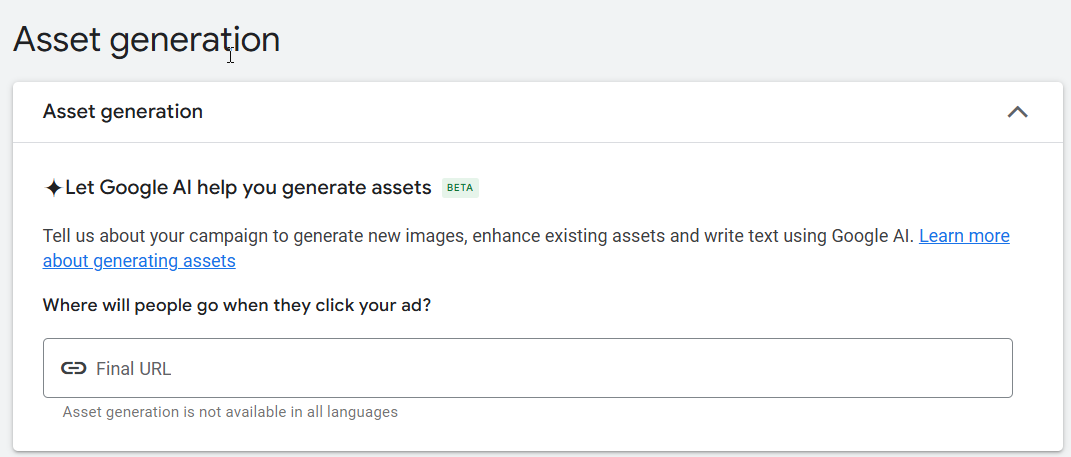
Asset Groups (A.k.a. “Ads”)
Think of asset groups as the PMax version of ad groups. This is where most of your setup will happen.
Each asset group should be tied to a theme, product, or audience segment. For example, you might have one group targeting branded products, another for generic categories, and a third for seasonal promos.
Each group contains:
- Brand Guidelines: You can control how your brand appears by inputting a business name, logo(s), custom colors, and font.
- Headlines: Up to 15 headlines can be added. Each headline has a 30-character limit.
- Long Headlines: Up to five long headlines can be added. Each has a 90-character limit.
- Descriptions: Up to five descriptions with a 90-character limit.
- Images: Up to 20 images can be added. A combination of landscape, square, and portrait orientations is recommended.
- Video: While not required, these are highly encouraged. If you don’t have a video, Google will automatically create one in most cases, depending on the completeness of your assets. Up to five videos can be added.
- Sitelinks: At least two are required in order for sitelinks to show in ads. The recommended number is at least four.
- Call to Action: This can be automated, where Google tests different CTAs, or you can choose from different options.
- Audience Signals: Be sure to add relevant audience signals, such as customer lists or in-market segments, to help Google find new customers faster.
- Search Themes: Add up to 50 words or phrases people use when searching for your product or service.
- Final URL or feed link: This is where the user will be directed after clicking on an ad.
Google does have the option to use automatic asset optimization, including these three categories:
- Text: Customization and final URL expansion.
- Image: Enhancement and landing page images.
- Video: Enhancement.
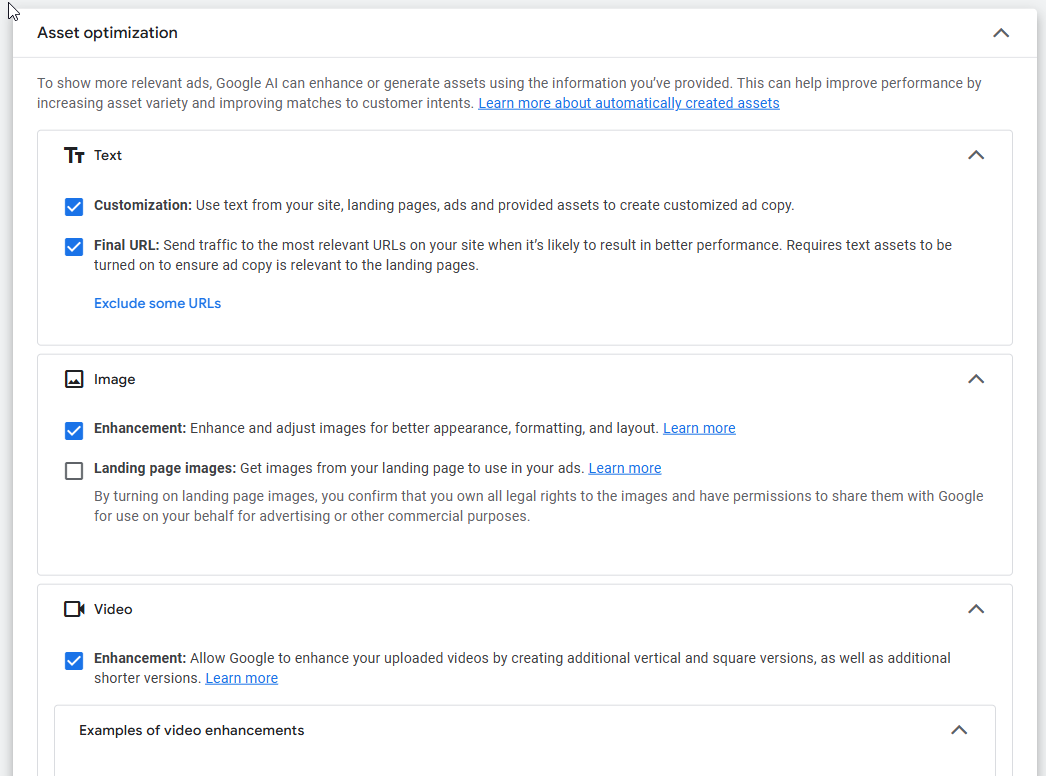
You can opt in or opt out by checking the boxes for each of them.
It’s important to note that with audience signals, think of them more like audience “suggestions.”
By adding audience signals, your campaigns can be targeted to those signals, but not exclusively.
Google will use the audience signal inputs to identify similar customers who are more likely to purchase your product or service.
From experience, start by adding your first-party audience lists to capture as many relevant new customers as possible.
Lastly, additional (and optional) asset types can be set at this level, including:
- Promotions.
- Prices.
- Calls.
- Structured snippets.
- Lead forms.
- Callouts.
- Display path.
What Kind Of Reporting Does Performance Max Have?
One of the biggest critiques of Performance Max early on was the lack of visibility.
Advertisers couldn’t see what channels their ads were showing on, what search terms were triggering clicks, or which creative combinations were actually working. It felt like running a campaign blindfolded.
Thankfully, that’s no longer the case.
While PMax still isn’t as transparent as traditional campaign types, Google has rolled out several major reporting updates over the past year, especially in response to advertiser feedback. Here’s what you can look at to evaluate performance today.
Channel-Level Reporting
This has been one of the most important updates in recent memory. With channel breakdowns, you can now see how your campaign is delivering across:
- Search.
- YouTube.
- Display.
- Gmail.
- Discover.
- Maps.
This is critical for understanding where your budget is going. If you notice the majority of conversions are coming from Search and Display, but YouTube is eating up 40% of the spend without results, that’s a red flag.
While you can’t directly adjust bids per channel, this insight helps you make more informed decisions about creative, exclusions, or asset group adjustments.
Search Term Insights
Up until Google Marketing Live 2025, Google provided search category themes within the Insights tab to help you understand the types of queries driving your ads.
These aren’t exact match queries like in Search campaigns, but rather high-level themes grouped by relevance.
Just announced this year, more granular search term reporting is rolling out, giving advertisers a closer look at actual search behavior driving performance. It’s not fully comprehensive yet, but it’s a step toward more actionable optimization.
Asset Group And Asset-Level Performance
Each asset group now includes performance metrics like:
- Impressions.
- Clicks.
- Conversions.
- Conversion Value.
- Click-Through Rate (CTR).
You can also view asset-level ratings (Low, Good, Best) to gauge which combinations are resonating. These qualitative signals may feel vague, but they can help you identify which headlines or images deserve a refresh.
If one asset group is consistently outperforming others, use it as a blueprint. Review the messaging, creative tone, and audience signal tied to it. Then, test those learnings across other asset groups.
Audience Signal Contribution
While audience signals in PMax don’t act as strict targeting filters, you can now get visibility into how well they’re assisting the system.
This shows up in the Insights tab and helps you understand which segments (e.g., website visitors, in-market audiences, custom segments) are contributing to conversions.
If a particular audience signal shows low engagement, it may be time to swap it out or build new custom segments based on updated behaviors.
What Is The Difference Between Performance Max, Search Ads, And Demand Gen Ads?
Performance Max is certainly a different breed of campaign type.
According to Google, PMax is meant to complement keyword-based Search campaigns to help drive more customers. They are not meant to be a replacement.
There are three key differences between the different campaign types:
- Placements.
- Intention.
- Targeting options.
Below is a quick comparison chart of how these three campaign types differ.
| Feature | Performance Max | Search | Demand Gen |
| Channels | All Google inventory | Search and Search Partners | YouTube, Discover, Gmail |
| Targeting | Automated (audience signals and search themes are optional) | Keyword-based | Lookalikes, custom segments, remarketing |
| Creative | Asset-based | Text-based ads | Image and video-based ads |
| Reporting Transparency | Improving, but still automated | High | Moderate |
| Ideal for | Ecommerce, omnichannel | Intent-based targeting | Visual storytelling and top-of-funnel demand |
PMax is often best when paired with Search, not instead of it. And if you’re already running video or Display campaigns, Demand Gen might be better suited for upper-funnel goals.
→ Read more: Performance Max Vs. Search: A Non-Scientific Look On If It Competes And What It Means
What Are The Benefits Of Performance Max?
Performance Max is designed to simplify campaign management while scaling your reach across Google’s entire network. But, the real value comes when you go beyond surface-level automation and treat PMax as a tool for strategic growth.
Here’s what it can offer when used correctly:
- Streamlined Access To Every Google Channel: Rather than building and managing separate campaigns for Search, Display, YouTube, and Discovery, PMax consolidates that effort. You can reach customers wherever they’re browsing, searching, or watching.
- Efficiency In Creative Delivery: Your uploaded assets (text, images, and videos) are automatically mixed and matched to create combinations tailored to each user and placement. This saves time on creative testing and makes it easier to launch full-funnel campaigns without manually managing dozens of ad variants.
- Smarter Optimization Through AI: PMax uses real-time signals like search intent, browsing behavior, device, location, and time of day to determine when and where to serve ads. This goes far beyond manual rules or bid adjustments. For advertisers with solid conversion tracking in place, Smart Bidding can dramatically improve efficiency over time.
- Discovery Of New Conversion Opportunities: Because you’re not limited to a keyword list or narrow targeting parameters, Performance Max can help uncover new audiences and surfaces you might not have reached otherwise, especially relevant for products with broad appeal or when expanding to new markets.
- Unified Campaign Management: PMax reduces operational complexity. Instead of optimizing multiple campaigns, channels, and strategies separately, you can manage budgets, creative, and conversion tracking in one place. This makes it easier to align internal teams around performance goals.
That said, these benefits only show up when the campaign is set up thoughtfully. Automation isn’t a magic bullet, but it can be a force multiplier if you feed it the right inputs.
Who Should Use Performance Max?
Performance Max works best for advertisers who are open to testing, have strong conversion signals, and are looking to scale beyond the limitations of a single channel.
But, it’s not a universal solution for everyone.
Here’s a breakdown of who should consider using it, and who might want to use caution when testing it out.
If any of these sound like you, strongly consider adding Performance Max to your campaign strategy.
- You’re an ecommerce brand. PMax has deep integration with Merchant Center, making it an excellent fit for retailers looking to scale Shopping campaigns while layering in additional surfaces like YouTube and Discover.
- You have meaningful conversion goals and accurate tracking. Without well-defined and trackable conversion actions, PMax won’t know what to optimize toward. Whether it’s lead forms, purchases, or phone calls, clean data is critical.
- You want to expand reach without managing every placement. For small teams or those stretched across multiple responsibilities, PMax can help simplify campaign ops while still pushing performance.
- You have high-quality creative assets across multiple formats. The more you give the system to work with (images, videos, ad copy), the better your chances of engaging users across all placements. Google’s AI does the heavy lifting, but your input defines the ceiling.
- You’re exploring new audiences, products, or geographies. When launching in a new market, PMax can quickly gather learnings by casting a wider net than Search alone. Just be sure to monitor the early signals closely.
On the other hand, these scenarios may not be ideal for you to venture out into PMax right away, or at least without crafting a strategy around it.
- You have highly niche or B2B targeting needs that require precision.
- Your conversions are low-volume, offline, or hard to track.
- You want full control over placements, bids, and messaging at all times.
In short, PMax is best suited for performance-driven advertisers with clear goals and enough data to fuel automation. If that’s you, it’s worth testing.
5 Best Practices For Performance Max
To get the most out of Performance Max, you need more than just a campaign setup. You need to structure it for learning, control what you can, and stay vigilant on performance signals.
Here are five ways to approach it:
1. Start With Strong Audience Signals.
While Google doesn’t only use the audiences you provide, giving it the right starting point can reduce learning time and steer your campaign in the right direction.
These can include custom segments, website visitors, and even customer relationship management-based lists. Group them thoughtfully by intent or lifecycle stage, not just demographic categories.
2. Invest In Quality Creative Across Formats
One of the biggest performance gaps in PMax comes from weak or missing creative.
Google prefers asset diversity: square and landscape images, vertical videos, multiple headlines, and descriptions. If you leave key formats blank (like video), Google will auto-generate them, and the results may not reflect your brand well.
Aim for at least three to five strong creatives per format in every asset group.
3. Lean On Reporting – Even If It’s Not Perfect
While reporting in PMax isn’t as robust as traditional Search, it’s improved significantly. Review channel-level performance, asset group insights, and search themes regularly.
If one asset group is outperforming, look at what messaging and visuals are being used, and apply that learning to other groups.
4. Proactively Use Exclusions And Conversion Rules
Don’t wait until performance tanks to apply controls. Set negative keywords, brand exclusions, and URL rules early. Define what counts as a valuable conversion in your account.
This helps Smart Bidding optimize toward meaningful outcomes rather than vanity metrics or low-quality leads.
5. Select The Appropriate Goal And Targets For Bidding Strategy
It’s important to have some sort of idea of what a customer is worth to you.
If you have historical key performance indicators (KPIs) of target CPA or target ROAS, use those as a starting point when setting your bid strategy.
Setting the goals too high or too low can produce significant volatility in campaign performance.
For example, a typical branded search campaign likely has a much higher ROAS than a non-branded campaign.
Don’t set your conversion targets in accordance with what you see for brand terms. By doing so, targeting and reach may become limited, which means fewer conversions and poor performance.
Set Your Next Performance Max Campaign Up For Success
Performance Max has come a long way from where it started. It’s more flexible, more transparent, and better suited for advertisers who want to scale without giving up all control.
The recent improvements (especially the reporting upgrades and creative tools) show that Google is listening, at least in part, to advertiser feedback.
But success with PMax still comes down to strategy. It works best when paired with clean data, strong assets, and someone who’s willing to dig into the details.
If you’re willing to guide the machine, there’s real potential here.
More Resources:
- 11 Tips To Get The Best Out Of Performance Max Campaigns
- Google PMax: Inside The Negative Keyword Limit Increase & What’s Next
- PPC Trends 2025
Featured Image: N Universe/Shutterstock

